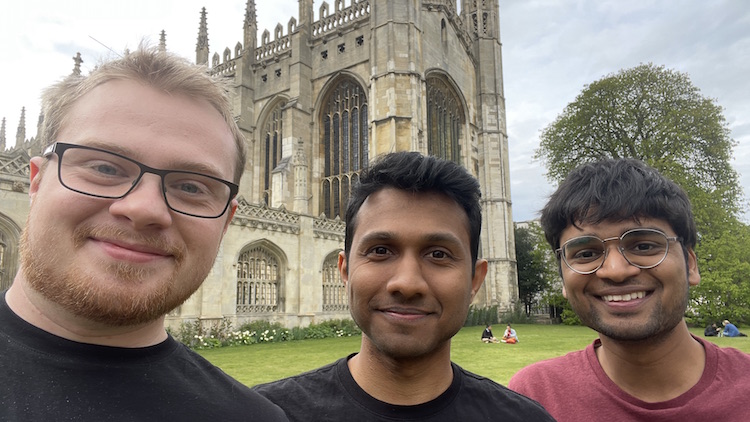
Take three PhD students, throw them in with nearly 40 architects, data scientists, infrastructure engineers and researchers, challenge them to find a way for interoperable data to help save the world and leave them to sweat for six hours. This was the recipe for the Centre for Digital Built Britain’s (CDBB) recent hackathon.
The hackathon took place at Anglia Ruskin University in Cambridge in early March.
Henry Fenby-Taylor, head of information management at the CDBB, outlined the brief for the day: to explore ways in which the use of interoperable data could help to make the industry more sustainable and resilient for the future, while delivering positive, tangible solutions to managing the impact of climate change. The purpose of the exercise was to provide an answer to the question: can data save the world?
Taking part was Team FIBE: three PhD students from the Future Infrastructure and the Built Environment course in the Department of Engineering at Cambridge University.
The team – James Walsh, Haritha Jayasinghe and Shagun Garg – envisioned a web-based app that generates passports that help to keep track of a building’s updates and repairs, improving the whole life-cycle analysis of a built asset. The team secured the hackathon’s sustainable development prize.
BIMplus caught up with two of the trio, Walsh and Jayasinghe, to find out more about their entry and the hackathon itself.
What happens at a hackathon?
James Walsh (JW): Usually they’re multi-day events. You might sleep overnight or keep yourself caffeinated the entire time. The aim is to produce a hacky project: in British terminology, a hack is a bodge. This one was only around eight hours and in that compressesd time frame, your output is more likely to be a presentation rather than an app.
Haritha Jayasinghe (HJ): This was more about the concept than the execution.
What drew you to this hackathon?
JW: We attended a lecture by Dr Jennifer Schooling OBE [director at the Cambridge Centre for Smart Infrastructure and Construction]: her presentation was quite remarkable. That’s what put the CDBB on our radar.
Talk us through your winning concept
HJ: We worked on building an IFC explorer that aims to extract relevant information from a 3D model that can then be fed to a life-cycle analysis (LCA) dashboard. Our product can be used to generate detailed building passports, keeping a track of building updates and repairs without losing the original information (like version control).
JW: We built it mainly with Python and React. The end product is a visualisation platform to analyse the LCA of different materials used in the building by extracting the relevant information from a BIM file. This platform can be extended in the automatic generation of material passports, issuing performance certificates.

Tell us more about the genesis of the idea
HJ: Our idea is driven by the fact that there’s a lot of information out there that exists in various different forms but not in very accessible forms, whether pdfs of IFC files. If you look at an IFC file, for example, there are so many fields but there’s still room for recording so much more information, like embedded carbon. Even when that data is recorded there, you don’t see a tangible way of visualising it. Thus our idea was to come up with a way to easily summarise that critical information.
JW: I hate proprietary, locked down and difficult to share software. So the idea was to build an open source web app that you load your file into, it does whatever you’re going to want with the file to begin with and then specialise from there. My perspective is more of this industry requires well-maintained open-source software. Greater accessibility and privacy controls in this field means information would be easier to share, so more people can contribute and quickly be on the same wavelength.
I recognise the visualisation element is something that’s already being done, but open access and metrics generating “insight” has continued relevance to digital twins.
What challenge did you run into?
JW: There are not enough publicly available datasets in the construction industry. What we would like to see in the future is different stakeholders actively contributing to the central theme of sustainability and resilience by contributing their domain knowledge, making data publicly available and easily assessable.
Were you confident you were going to win?
JW: No, no. We aren’t industry: we’re a bunch of PhD students who rocked up thinking it would be fun. We found out that it was an industry-focused session.
HJ: I realised during the lunch break that our competitors were from industry with years of experience.
What’s next for your idea?
HJ: One of the online participants at the hackathon liked our idea and we’re discussing how we can collaborate. It’s linked to the research that we’re doing. My PhD project, supervised by Prof Ioannis Brilakis, is digitising industrial facilities – and a lot of that is about creating digital twins, which relies on BIM models and the information in them.
JW: Similarly, my PhD project, supervised by Dr Cyrille Dunant, attempts to measure how early-stage design decisions impact on sustainability. We’re both part-funded by Aveva, and Haritha also has part-funding from BP.
What would you say to someone entering their first hackathon?
JW: Give it a go and have fun. Bring a mask, especially if it’s a 48-hour hackathon – there’s no time to wash – it can smell quite bad! And I personally choose to keep caffeinated.
HJ: There’s no reason to be intimidated by other people at the hackathon: it’s good fun and it’s about ideas (which aren’t tied to experience). It’s a great way to meet people and network.
JW: It’s a safe space. It’s open to begin with and then you can sort of see where it where it takes you. And you know, if you walk away doing something completely different, completely wild and different to what you had in mind when you went in, that’s also great, because then that probably means you learned something.
Addressing industry need
CDBB’s Fenby-Taylor made the point that as much as the hackathon was fun, it served an urgent, real world purpose: “Innovation is at the heart of improving our economy to meet the challenges of climate change. To do that we need better data to make better decisions: this hackathon highlighted not only how much data is available, but also, how much more there is to do. It is imperative that we have accessible, exploitable and editable data available that we can rely on to make better climate resiliency decisions in the future.
“Hackathons are such an important tool for what is quite a traditional and conservative industry. I hope this persuades people that sometimes taking the gloves off and letting people run with ideas can yield real change that can benefit all of society.”
Don’t miss out on BIM and digital construction news: sign up to receive the BIMplus newsletter.












